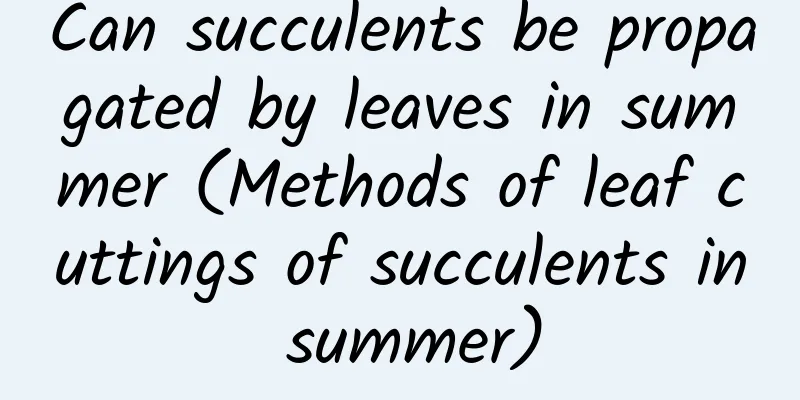Can succulents be propagated by leaves in summer (Methods of leaf cuttings of succulents in summer)

Can I grow succulents through leaf transplanting in summer?The method of propagating succulents using leaves is called "leaf cuttings". It is both the main method of propagating succulents and the lowest cost method. Although the operation is simple, it takes a long time. It generally needs to go through the main growth stages of rooting, germination, natural consumption and drying of mother leaves, and transplanting. It takes about 2-3 months and is quite a test of patience. Moreover, the germination rate and survival rate of leaves of different varieties are different. Most Sedum popular science products and other varieties whose leaves are easy to peel off completely are relatively easier to succeed. Varieties whose leaves are difficult to peel off completely or whose leaves are thin or hairy are generally not propagated by leaf cuttings. Temperature and humidity should be controlled for succulent leaf cuttings in summerThe main growing season of succulents is in spring, autumn and early winter, with short dormancy periods during high temperatures in summer and cold winter. Therefore, leaf cuttings are best carried out in an ambient temperature between 15-30℃. Not only will the roots grow quickly, but the leaves are also less likely to rot and become waterlogged, and the survival rate is also higher. Although leaf cuttings take root faster in summer, the cultivation environment should be kept cool and ventilated and the cutting medium should not be too moist, otherwise the leaves will easily rot and become waterlogged due to high temperature and humidity. In winter, you need to take insulation measures or use a seedling box to grow seedlings. Otherwise, the ambient temperature will be too low, and not only will the leaves be easily frostbitten, but the long-term low temperature environment will prevent them from taking root, and instead cause tumors at the growing point. When doing leaf cuttings in the summer, it is best to avoid the hottest months of July and August in areas with hot climates, because the probability of black rot and waterlogging of leaves in the high temperature environment in summer is higher than in the spring and autumn when the climate is suitable. Leaves that have black rot and waterlogging should be picked out in time. Secondly, in order to reduce losses, you can also add a little fungicide when watering the leaf cuttings, which is also helpful to improve the survival rate of leaf cuttings in summer. Finally, daily maintenance after the leaves sprout to avoid water accumulation and maintain good ventilation is also critical. |
Recommend
Why does mom always bring back wild vegetables? I didn’t understand it when I was a child, but now I know that “wild vegetables” are really good things!
No matter how you persuade the little ones, they ...
Pecan planting conditions and propagation methods
Pecan , also known as American pecan, is a nut pl...
Before and after the New Year, go to this secret base to pick flowers and grow them without spending a penny!
The secret base for picking flowers at the flower...
How to grow spathiphyllum at home
Growing conditions of spathiphyllum The best grow...
The difference between the Red Leaf Festival and the Fire Festival
1. Different varieties The "variety" me...
How to prune canna
When to prune cannas Canna is generally suitable ...
Can hand-twisted gourds be potted?
Can hand-twisted gourds be potted? Hand-twisted g...
Ginseng cultivation methods and precautions
1. Maintenance methods 1. Temperature: The most s...
How to grow succulent money tree
The soil that nourishes money strings: Soil is th...
Experts have created a four-step flower-growing method. If you learn it, you will be a master of flower-growing.
Step 1: Choose a substrate that is both water-ret...
How many baby's breath seeds are placed in a pot, and what color is it?
1. How many to put in one pot When planting baby&...
Will the fortune tree bloom?
Will the fortune tree bloom? Regarding the questi...
What to do if white peony drops leaves
reason Normal reaction after repotting If the lea...
What does camellia look like and what are its characteristics?
1. What does it look like? Camellia is a small tr...
Introducing the six essentials of flower arrangement
Six essentials of flower arrangement (1) Heights ...









